Latin America
- Area: Latin America
- Cartoonist: Nillson-Maki
- Explanation: The cartoon depicts Hugo Chavez rolling on top of an oil barrel, escaping an angry mob of Venezuelan citizens. Chavez is infamous for taking money that would benefit his fellow citizens and channeling it towards projects that promote his own political agendas. Therefore, the cartoonist is very practical as the drawing and sketches utilize all the necessary features in relaying the intended message to the society. Features in the portrait Hugo Chaves such as oil barrel and an angry mob, help the readers to decipher corruption. According to Kange, corruption is a factor that is affecting many developing countries and has hampered their development and progress (14). The cartoon also acts as a warning to leaders who engage in corrupt practices since they can face the wrath of current citizens who are more enlightened than the preceding generations.
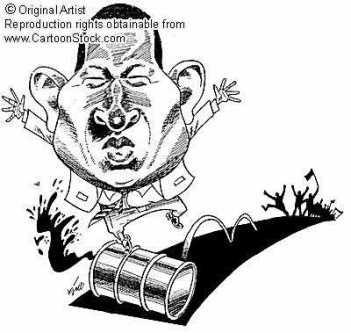
Western Europe
- Area: The United States
- Cartoonist: Glenn McCoy
- Explanation: The cartoonist uses the cartoon of an individual explaining the challenges that people can experience when they engage in global warming activities. The activities, which relate to global warming, create harm in the world in terms of increasing the average temperature of the world. According to Brooks (162), it is imperative that people try to save the world from the effects of global warming. From the cartoon, a picture develops in the minds of readers that global warming is a global challenge. The implication of a cartoon that develops in the minds of readers is an amplified attempt to minimize activities that increase the world’s vulnerability to global warming. The message conveyed by the cartoons also encourages people to engage in operations that reduce the negative effects that global warming has on the sustainability and long life of the planet.

Japan
- Location of Japan
- Cartoonist: Bill Schorr
The main message that the cartoon brings to the fore includes the disasters that are impending in Japan. The cartoonist uses the drawing to express the future of the world and the consequences that came along with global warming. According to the cartoonists, many individuals engage in careless behavior that does a lot of harm to the earth and reduces its ability to sustain and accommodate future generations. Some of these behaviors include pollution, nuclear tests, and the use of agrochemicals. Bolen and Robison argue that global warming is a critical issue that can result in wildfires, unprecedented changes in weather patterns, earthquakes, hurricanes, and tornados (161). The cartoon depicts some of the consequences that global warming occasion, which includes earthquake and tsunami.
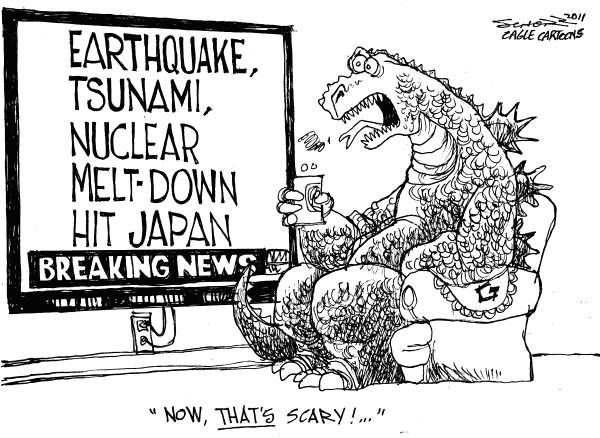
China and Sub-Sahara Africa
- Area: Sub-Sahara Africa
- Cartoonist: Adenle Adewale
- Explanation: This is one of a series of cartoons published in 1996 demonstrating the frustration of the Nigerian people. The cartoon shows a Nigerian citizen, nailed down by an oppressive General Sanai Abacha and his regime, literally starving for democracy. The cartoon sends a number of messages to the society that concern corruption, misuses of resources, and democracy. According to cartoonists, many individuals in developing countries are starving for democracy. Corruption is a prevalent vice in many developing countries, as most of their leaders have greed for power and money (Steinberg 11). From the cartoon and sketches, it is clear that leaders of these nations prevented their citizens from gaining get the much-needed democracy but instead remain nailed as slaves of the country.
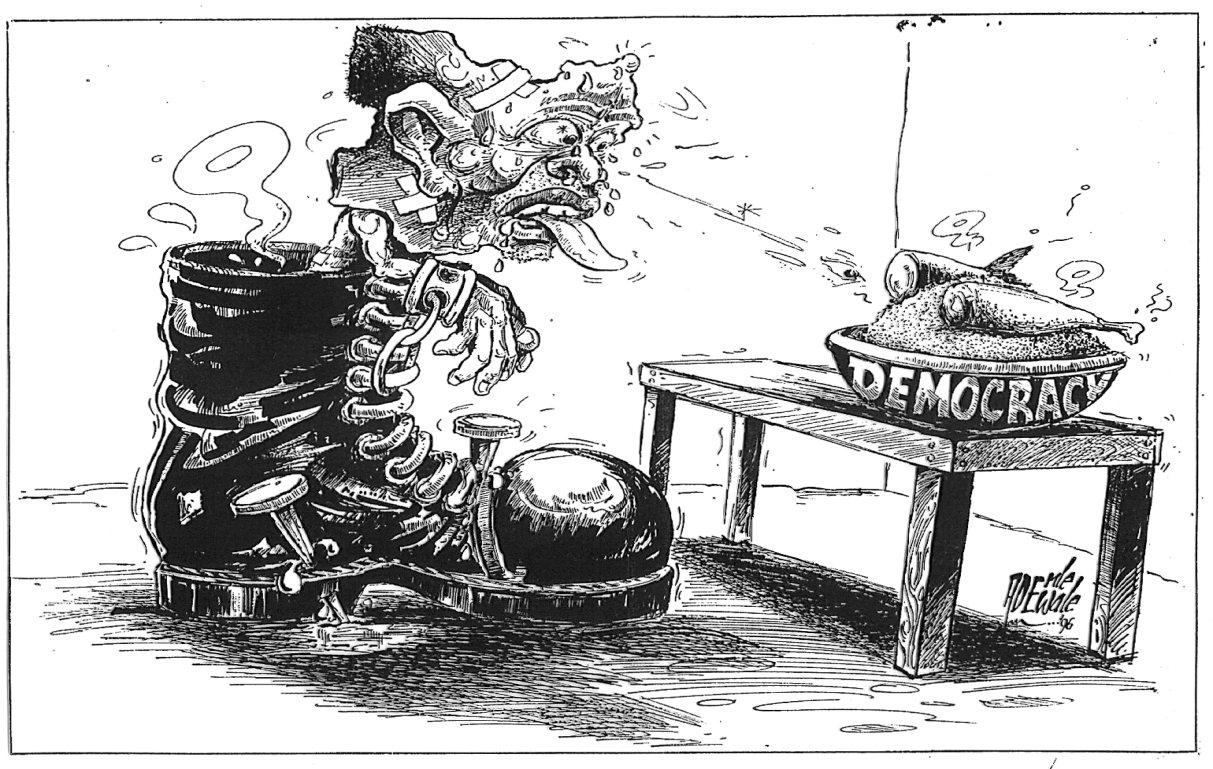
The Middle East and North Africa
- Location: Afghanistan
- Cartoonist: John Cox and Allen Forkum
- Explanation: In the cartoon, the cartoonist uses the cartoon of Iran leader Mahmoud Ahmadinejad to create awareness in the minds of people living in nations and states to explain the importance of curbing nuclear proliferation and its negative impacts. The cartoonist uses a sketch that shows the president of Iran, expressing his need to destroy countries such as the United States and Israel using nuclear weapons. In the cartoonists’ assertion, weapons of mass destruction aimed at destroying Israelites and Americans. Dobson (45) argues that the unchecked use of nuclear energy can proliferate the manufacturing and the use of nuclear weapons. Thus, the use of the cartoon is very instrumental in presenting the impact of nuclear weapons on global security.
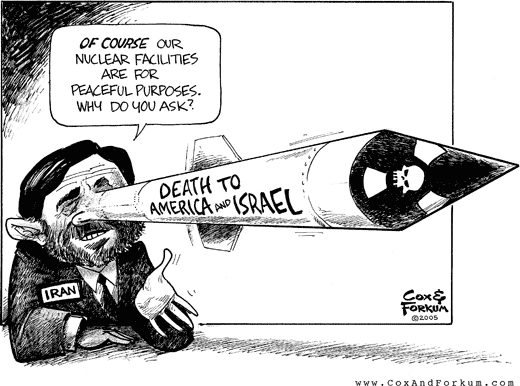
India
- Area: India
- Cartoonist: Satish Acharya
- Explanation: The cartoon depicts that citizens of India have been through the regimes that tolerate injustices. Corrupt practices have dominated the Indian regimes, which have contributed to systemic impunity in the judiciary. As the current regime wants to free known killers of a political leader, it elicits uproar in India. From the cartoon, it is evident that decades have passed while citizens are still expecting justice, although past regimes denied them. While a man is looking for justice for his father, another is seeking justice for the 1980s events, and some are seeking justice for recent events. This implies that the regimes in India have continued to perpetuate injustices against their citizens by delaying and denying them justice. In essence, the demonstration that is evident in the cartoon depicts hungry protesters who are determined to achieve their respective justice, no matter the delays or denials that they encounter.
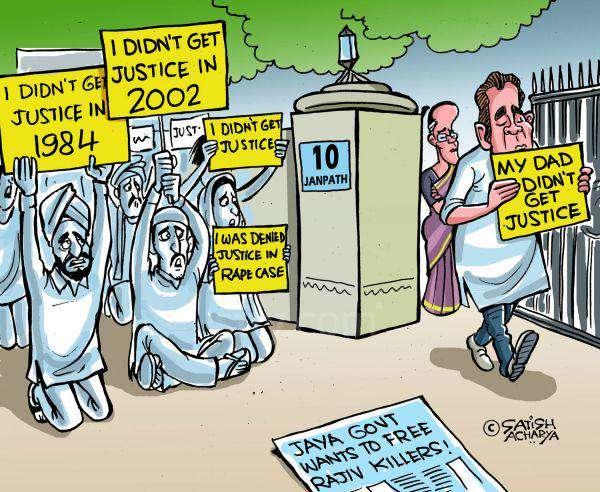
Eastern Europe and Russia
- Location: Russia
- Cartoonist: Mark Roberts
- Explanation: The cartoons here comprise of some individuals who are discussing issues regarding nuclear testing. Through the cartoons, a picture develops in the minds of readers concerning the divergent perspectives held by individuals on aspects that regard nuclear weapons. The cartoonist employs complex political concepts to make the discussion among the cartoons interesting and creative. With the use of terms such as the jellyfish, vertebrates, and global fish stock, the cartoonist conveys the intended message. According to Cirincione, the presence of nuclear weapons in the world is a threat to humanity because they have the potential of causing massive destruction (10). Therefore, the cartoonist is conveying a very crucial message to the society concerning the use of nuclear weapons.
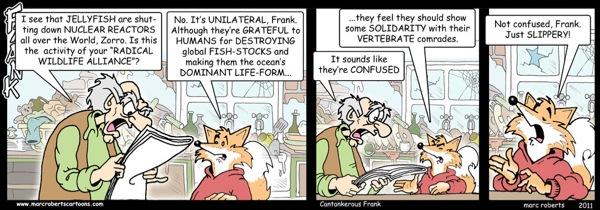
Philippines
- Location: Philippines
- Cartoonist: Pat Bagley
- Explanation: Since the Philippines frequently experience natural disasters such as typhoons, hurricanes, and floods, the cartoonist in depicting the experience that people undergo. In the cartoon, there is a young family made of father, mother, and a child who are conversing about the experience of the disaster that hit them. The disaster has destroyed their house, and they are seated outside, wondering what next about their lives. The family is in a desolate and hopeless state because the disaster has destroyed their property and thus makes them homeless and poor. Typhoon Haiyan rocked the Philippines late last year and left thousands of people under dilapidated conditions that require humanitarian aid to improve their lives and survive.
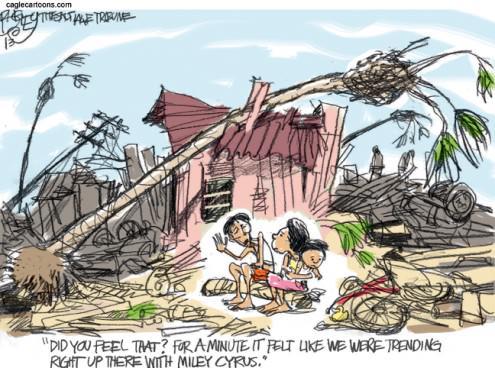
Southeast Asia
- Location: China
- Cartoonist: Willa Chen
- Explanation: The sketch is an illustration of a processing plant in China that manufactures certain products. From the sketch, it is clear that the plant emits high amounts of smoke that are harmful to the environment. Therefore, using the sketch, the cartoonist sends a message to the readers that pollution is harmful to society as it destroys the environment. Harrison argues that pollution occurs when individuals introduce harmful substances in a given environment (47). In the sketch, the smoke is black in color and is voluminous, which implies that the amount of harm that it has on the environment is very high and pronounced. The use of a small processing plant demonstrates the pollution magnitude of big processing plants. In addition, the sketch brings to the fore the pollution effects that processing plants have on the environment, water, soil, and air.
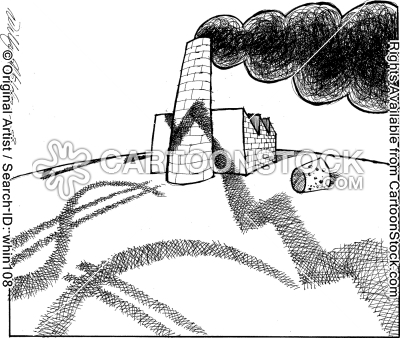
Africa
- Location: Africa
- Source: My drawing
- Cartoonist: Me
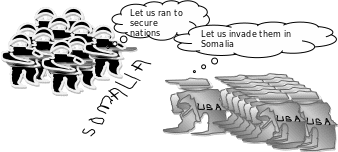
- Explanation: The cartoons depict Alshaabab, which is a terror group linked to Al-Qaeda terrorists fighting against the United States Army in Somalia. In the cartoon, Alshaabab is running away from Somalia into safe countries such as Kenya and Tanzania. As the United States and the United Nations started to invade Somalia, terrorists escaped and hid in other African countries. Thus, the cartoonist explains that although the United States and the United Nations’ Army invaded Somalia and dealt with the terrorists, they did not destroy all of them because some escaped and hid in some African Countries.. Therefore, the cartoon conveys a message to the society that terrorism is a global crisis and that all the individuals in the world have the responsibility of preventing the crisis (Phillips 25). The use of simple features enables readers to decipher the complexity of the issue of terrorism and Alshaabab globally.
Works Cited
Bolen, Eric and William Robison. Wildlife Ecology and Management. New Jersey: Prentice Hall/Pearson Education, 2003. Print.
Brooks, Charles. Best Editorial Cartoons of the Year: 2009 Edition. New Orleans: Pelican publishers, 2008. Print.
Cirincione, Joseph. Bomb Scare: The History and Future of Nuclear Weapons. Columbia: Columbia University Press , 2013. Print.
Dobson, Hugo. Japan and the G7/8: 1975-2002. New York: Routledge, 2004.Print.
Harrison, Roy. Pollution: Causes, Effects and Control. London: Royal Society of Chemistry, 2001. Print.
Kange, Augustine. Governance Challenges and Opportunities: A Qualitative Exploration of Leadership in Cameroon. Michigan: ProQuest, 2006. Print.
Phillips, Douglas. America’s Role in Changing the World. New York: Infobase Publishing, 2010. Print.
Steinberg, Paul. Environmental Leadership in Developing Countries: Transnational Relations and Biodiversity Policy in Costa Rica and Bolivia. New York: MIT Press, 2003. Print.